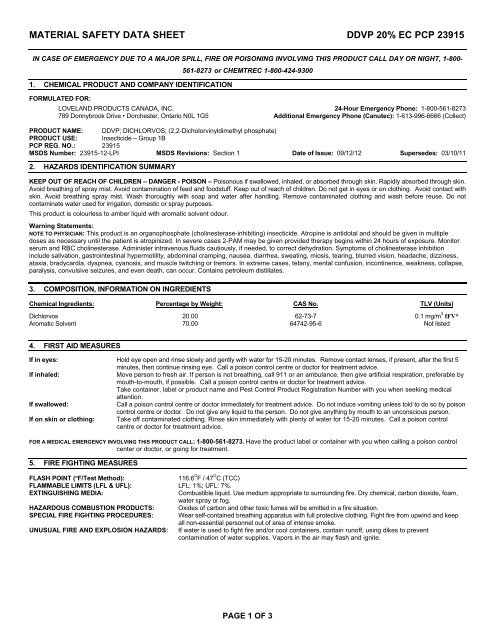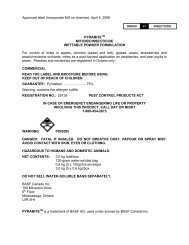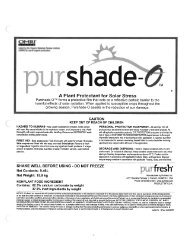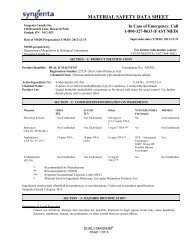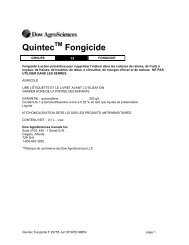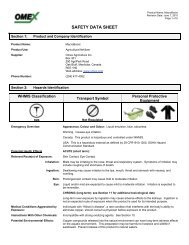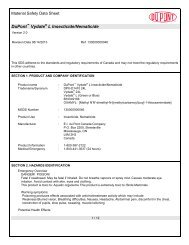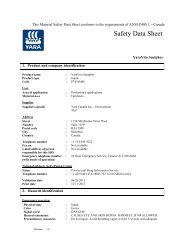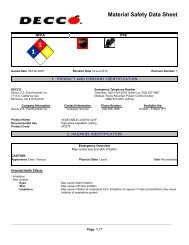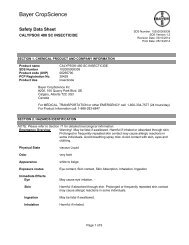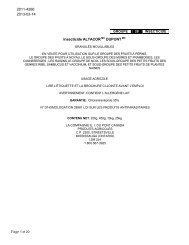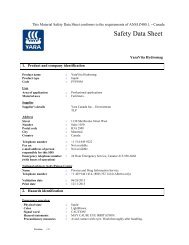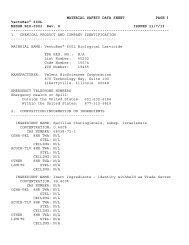DDVP msds english.pdf - Bartlett.ca
DDVP msds english.pdf - Bartlett.ca
DDVP msds english.pdf - Bartlett.ca
- No tags were found...
You also want an ePaper? Increase the reach of your titles
YUMPU automatically turns print PDFs into web optimized ePapers that Google loves.
MATERIAL SAFETY DATA SHEET <strong>DDVP</strong> 20% EC PCP 23915IN CASE OF EMERGENCY DUE TO A MAJOR SPILL, FIRE OR POISONING INVOLVING THIS PRODUCT CALL DAY OR NIGHT, 1-800-1. CHEMICAL PRODUCT AND COMPANY IDENTIFICATIONFORMULATED FOR:561-8273 or CHEMTREC 1-800-424-9300LOVELAND PRODUCTS CANADA, INC. 24-Hour Emergency Phone: 1-800-561-8273789 Donnybrook Drive • Dorchester, Ontario N0L 1G5 Additional Emergency Phone (Canutec): 1-613-996-6666 (Collect)PRODUCT NAME: <strong>DDVP</strong>; DICHLORVOS; (2,2-Dicholorvinyldimethyl phosphate)PRODUCT USE: Insecticide – Group 1BPCP REG. NO.: 23915MSDS Number: 23915-12-LPI MSDS Revisions: Section 1 Date of Issue: 09/12/12 Supersedes: 03/10/112. HAZARDS IDENTIFICATION SUMMARYKEEP OUT OF REACH OF CHILDREN – DANGER - POISON – Poisonous if swallowed, inhaled, or absorbed through skin. Rapidly absorbed through skin.Avoid breathing of spray mist. Avoid contamination of feed and foodstuff. Keep out of reach of children. Do not get in eyes or on clothing. Avoid contact withskin. Avoid breathing spray mist. Wash thoroughly with soap and water after handling. Remove contaminated clothing and wash before reuse. Do notcontaminate water used for irrigation, domestic or spray purposes.This product is colourless to amber liquid with aromatic solvent odour.Warning Statements:NOTE TO PHYSICIAN: This product is an organophosphate (cholinesterase-inhibiting) insecticide. Atropine is antidotal and should be given in multipledoses as necessary until the patient is atropinized. In severe <strong>ca</strong>ses 2-PAM may be given provided therapy begins within 24 hours of exposure. Monitorserum and RBC cholinesterase. Administer intravenous fluids <strong>ca</strong>utiously, if needed, to correct dehydration. Symptoms of cholinesterase inhibitioninclude salivation, gastrointestinal hypermotility, abdominal cramping, nausea, diarrhea, sweating, miosis, tearing, blurred vision, headache, dizziness,ataxia, brady<strong>ca</strong>rdia, dyspnea, cyanosis, and muscle twitching or tremors. In extreme <strong>ca</strong>ses, tetany, mental confusion, incontinence, weakness, collapse,paralysis, convulsive seizures, and even death, <strong>ca</strong>n occur. Contains petroleum distillates.3. COMPOSITION, INFORMATION ON INGREDIENTSChemi<strong>ca</strong>l Ingredients: Percentage by Weight: CAS No. TLV (Units)Dichlorvos 20.00 62-73-7 0.1 mg/m 3 IFV*Aromatic Solvent 70.00 64742-95-6 Not listed4. FIRST AID MEASURESIf in eyes: Hold eye open and rinse slowly and gently with water for 15-20 minutes. Remove contact lenses, if present, after the first 5minutes, then continue rinsing eye. Call a poison control centre or doctor for treatment advice.If inhaled:Move person to fresh air. If person is not breathing, <strong>ca</strong>ll 911 or an ambulance, then give artificial respiration, preferable bymouth-to-mouth, if possible. Call a poison control centre or doctor for treatment advice.Take container, label or product name and Pest Control Product Registration Number with you when seeking medi<strong>ca</strong>lattention.If swallowed:Call a poison control centre or doctor immediately for treatment advice. Do not induce vomiting unless told to do so by poisoncontrol centre or doctor. Do not give any liquid to the person. Do not give anything by mouth to an unconscious person.If on skin or clothing: Take off contaminated clothing. Rinse skin immediately with plenty of water for 15-20 minutes. Call a poison controlcentre or doctor for treatment advice.FOR A MEDICAL EMERGENCY INVOLVING THIS PRODUCT CALL: 1-800-561-8273. Have the product label or container with you when <strong>ca</strong>lling a poison controlcenter or doctor, or going for treatment.5. FIRE FIGHTING MEASURESFLASH POINT (°F/Test Method):116.6 O F / 47 O C (TCC)FLAMMABLE LIMITS (LFL & UFL): LFL: 1%; UFL: 7%.EXTINGUISHING MEDIA:Combustible liquid. Use medium appropriate to surrounding fire. Dry chemi<strong>ca</strong>l, <strong>ca</strong>rbon dioxide, foam,water spray or fog.HAZARDOUS COMBUSTION PRODUCTS: Oxides of <strong>ca</strong>rbon and other toxic fumes will be emitted in a fire situation.SPECIAL FIRE FIGHTING PROCEDURES: Wear self-contained breathing apparatus with full protective clothing. Fight fire from upwind and keepall non-essential personnel out of area of intense smoke.UNUSUAL FIRE AND EXPLOSION HAZARDS: If water is used to fight fire and/or cool containers, contain runoff, using dikes to preventcontamination of water supplies. Vapors in the air may flash and ignite.PAGE 1 OF 3
MATERIAL SAFETY DATA SHEET <strong>DDVP</strong> 20% EC PCP 239156. ACCIDENTAL RELEASE MEASURESSTEPS TO BE TAKEN IF MATERIAL IS RELEASED OR SPILLED:Contain spill and absorb with suitable absorbent, sweep up material and transfer to containers for possible land appli<strong>ca</strong>tion according to label use or forproper disposal. Wash spill area with water containing strong detergent, absorb and sweep up as above. Check lo<strong>ca</strong>l, state and federal regulations forproper disposal.CAUTION: Keep spills and cleaning runoff out of municipal sewers and open bodies of water.7. HANDLING AND STORAGEHANDLING:STORAGE:Wash hands before eating, drinking, chewing gum, using tobacco or using the toilet. Remove clothing immediately if pesticidegets inside. Then wash thoroughly and put on clean clothing. Remove PPE immediately after handling this product. Wash theoutside of gloves before removing. As soon as possible, wash thoroughly and change into clean clothing.Store in original container only. Store away from children, domestic animals, food, feed, and water supplies. Keep containertightly closed when not in use. Do not contaminate water, food or feed by storage or disposal.Personal Protective Equipment: Appli<strong>ca</strong>tors and other handlers must wear: long sleeved shirt and long pants, chemi<strong>ca</strong>l-resistant gloves, such asbarrier laminate, butyl rubber, Nitrile rubber, or Viton®, chemi<strong>ca</strong>l-resistant footwear and socks, protective eyewear, chemi<strong>ca</strong>l-resistant apron whenmixing, loading, or cleaning equipment. In <strong>ca</strong>se of possible overhead exposure, chemi<strong>ca</strong>l-resistant head covering should be worn. Follow manufacturer’sinstructions for cleaning and maintaining PPE. If no such instructions for washables, use detergent and hot water. Keep and wash PPE separately fromother laundry. After each day of use, clothing or PPE must not be reused until it has been cleaned. For containers over 1 gallon and less than 5gallons in <strong>ca</strong>pacity: Mixers and loaders who do not use a mechani<strong>ca</strong>l system (probe and pump) to transfer the product must wear coveralls or achemi<strong>ca</strong>l-resistant apron in addition to other required PPE.8. EXPOSURE CONTROLS / PERSONAL PROTECTIONENGINEERING CONTROLS:RESPIRATORY PROTECTION:EYE PROTECTION:SKIN PROTECTION:When handlers use enclosed <strong>ca</strong>bs, or aircraft in a manner that meets the requirements listed in the worker ProtectionStandard (WPS) for agricultural pesticides [40 CFR 170.240 (d) (4-6)], the handler PPE requirements may bereduced or modified as specified in the WPS.If vapors or mists become excessive or exceed TLV, wear a NIOSH/MSHA approved pesticide respirator with<strong>ca</strong>rtridges for organic vapors.Chemi<strong>ca</strong>l goggles or shielded safety glasses.Wear protective clothing: long-sleeved shirts and pants, chemi<strong>ca</strong>l-resistant footwear and socks. Wear rubber orchemi<strong>ca</strong>l-resistant gloves.OSHA PEL 8 hr TWA ACGIH TLV-TWA<strong>DDVP</strong> 1 mg/m 3 (skin) 0.1 mg/m 3 IFV*9. PHYSICAL AND CHEMICAL PROPERTIESAPPEARANCE AND ODOR: Colourless to amber liquid with aromatic solvent odourSOLUBILITY: EmulsifiesSPECIFIC GRAVITY (Water = 1): 0.98 g/ml @ 20 O C BULK DENSITY: 0.98 kg/L. pH: ± 3.9 (1% emulsion)VAPOR PRESSURE: Not establishedBOILING POINT: 363 - 401 O F / 184 - 205 O CPERCENT VOLATILE (by volume): Not established EVAPORATION RATE (Butyl Acetate = 1): 0.1Note: These physi<strong>ca</strong>l data are typi<strong>ca</strong>l values based on material tested but may vary from sample to sample.Typi<strong>ca</strong>l values should not be construed as a guaranteed analysis of any specific lot or as specifi<strong>ca</strong>tion items.10. STABILITY AND REACTIVITYSTABILITY: StableCONDITIONS TO AVOID: Extreme heat. Sources of ingition.INCOMPATIBILITY: Strong bases, acids, and oxidizers.HAZARDOUS DECOMPOSITION PRODUCTS: Hydrogen chloride (HCl), phosphorous oxides, oxides of <strong>ca</strong>rbon, and other unknown hazardous materialsmay be formed in a fire situation.HAZARDOUS POLYMERIZATION: Will not occur.11. TOXICOLOGICAL INFORMATIONAcute Oral LD 50 (female rat): 56 mg/kgAcute Dermal LD 50 (rabbit): 205 mg/kgEye Irritation (rabbit): IrritantSkin Irritation (rabbit): IrritantInhalation LC 50 (rat): >198 mg/m 3 (4H)Skin Sensitization (guinea pig): Possible sensitizerCarcinogenic Potential: EPA lists Dichlorvos as EPA-B2: Probable Human Carcinogen with sufficient evidence from animal studies; inadequateevidence or no data from epidemiologic studies. ACGIH lists Dichlorvos as: TLV-A4: Not Classifiable as a Human Carcinogen. IARC lists Dichlorvos as2B: Possibly Carcinogenic to Humans. Not listed in OSHA or NTP.PAGE 2 OF 3
MATERIAL SAFETY DATA SHEET <strong>DDVP</strong> 20% EC PCP 2391512. ECOLOGICAL INFORMATIONThis product is toxic to fish, birds, and other wildlife. Do not apply directly to water. Do not contaminate water when disposing of equipment wash water.Do not apply when weather conditions favor drift from target area.13. DISPOSAL CONSIDERATIONSDo not reuse containers for any purpose. Refillable Container: For disposal, the container may be returned to the point of purchase (dealer/distributor). Itmust be refilled by the dealer/distributor with the same product. Container is recyclable, and is to be disposed of at a container collection site. Contactyour lo<strong>ca</strong>l dealer/distributor for the lo<strong>ca</strong>tion of the nearest collection site. Before taking container to the collection site: Triple or pressure-rinse the emptycontainer, adding the rinsate to the spray tank. Make the empty container unsuitable for further use. If there is no container collection site in your area,dispose of the container in accordance with provincial requirements. For information on disposal of unused, unwanted product, contact the manufactureror the provincial regulatory agency. Do not contaminate water, food, or feed by storage or disposal.14. TRANSPORT INFORMATIONDOT/TDG Shipping Description: RQ ORGANOPHOSPHORUS PESTICIDE, LIQUID, TOXIC, FLAMMABLE (DICHLORVOS, AROMATICHYDROCARBON), 6.1 (3), UN3017, III MARINE POLLUTANT ERG GUIDE 131U.S. Surface Freight Classifi<strong>ca</strong>tion: INSECTICIDES OR FUNGICIDES, INSECT OR ANIMAL REPELLENTS, NOI, OR VERMIN EXTERMINATORS,ANIMAL OR POULTRY, NOI; POISON (NMFC 102100; CLASS: 77.5)IMDG Shipping Description: RQ ORGANOPHOSPHORUS PESTICIDE, LIQUID, TOXIC, FLAMMABLE (DICHLORVOS, AROMATICHYDROCARBON), 6.1 (3), UN3017, III MARINE POLLUTANT ERG GUIDE 131Consult appropriate ICAO/IATA regulations for shipment requirements in the Air shipping modes.15. REGULATORY INFORMATIONNFPA & HMIS Hazard Ratings: NFPA HMIS2 Health 0 Least 2 Health2 Flammability 1 Slight 2 Flammability0 Instability 2 Moderate 0 Reactivity3 High H PPE4 SevereSARA Hazard Notifi<strong>ca</strong>tion/ReportingSARA Title III Hazard Category: Immediate __Y__ Fire __N__ Sudden Release of Pressure __N__Delayed __ N __ Reactive __N__Reportable Quantity (RQ) under U.S. CERCLA: <strong>DDVP</strong> (Dichlorvos) (CAS: 62-73-7): 10 pounds; Naphthalene (CAS: 91-20-3): 100 pounds (<strong>ca</strong>lculated inproduct: 15 pounds)SARA, Title III, Section 313: <strong>DDVP</strong> (Dichlorvos) (CAS: 62-73-7); Naphthalene (CAS: 91-20-3)RCRA Waste Code: Not listedCA Proposition 65: Not listed16. OTHER INFORMATIONMSDS STATUS: Section 1 revisedPREPARED BY: Registrations and Regulatory AffairsREVIEWED BY: Environmental Safety and Health®Viton is a registered trademark of DUPONT PERFORMANCE ELASTOMERS L.L.C.IFV*: Measured as inhalable fraction and vapour.Disclaimer and Limitation of Liability: This data sheet was developed from information on the constituent materials identified herein and does not relateto the use of such materials in combination with any other material or process. No warranty is expressed or implied with respect to the completeness orongoing accuracy of the information contained in this data sheet, and LOVELAND PRODUCTS CANADA, INC. disclaims all liability for reliance on suchinformation. This data sheet is not a guarantee of safety. Users are responsible for ensuring that they have all current information necessary to safely usethe product described by this data sheet for their specific purpose.PAGE 3 OF 3


